The visual arts
These are closely related to archaeology. They, too, are things we can look at and touch after all. The difference is very much one of interpretation. Are the Parthenon statues art or archaeology; is an ancient painted pot art or archaeology? In order to avoid such questions, many people use the term ‘material culture’ to cover both. For many purposes, the difference doesn't matter. In fact, it is a good illustration of the advantages of interdisciplinary work, with different kinds of approach illustrating the same issues. Like archaeology, visual arts can tell you things that literature can't, but still it is necessary to read the visual language, interpreting the meaning of the images and reconstructing a visual narrative if appropriate.
Using the word ‘arts’ evokes ideas of aesthetic appreciation and beauty, but the visual arts, like archaeology, and all other kinds of evidence, need to be interpreted, and interpreted in different ways. Take pots, again, as an example. When examining pots archaeologists need to think about:
what they depict (what do we learn from the scene on that pot?)
how they depict it (what do we learn from the style and material of that pot?)
who made and commissioned them (what do we learn from the fact that this pot was produced by a particular workshop in Athens for a rich man in southern Italy?)
where they are used (what do we learn from the fact that this pot was used at dinner parties and another in the kitchen?)
The more questions you can bring to them, the richer the visual arts will become for you – both as art objects in their own right and as a source for the Classical world more widely.
